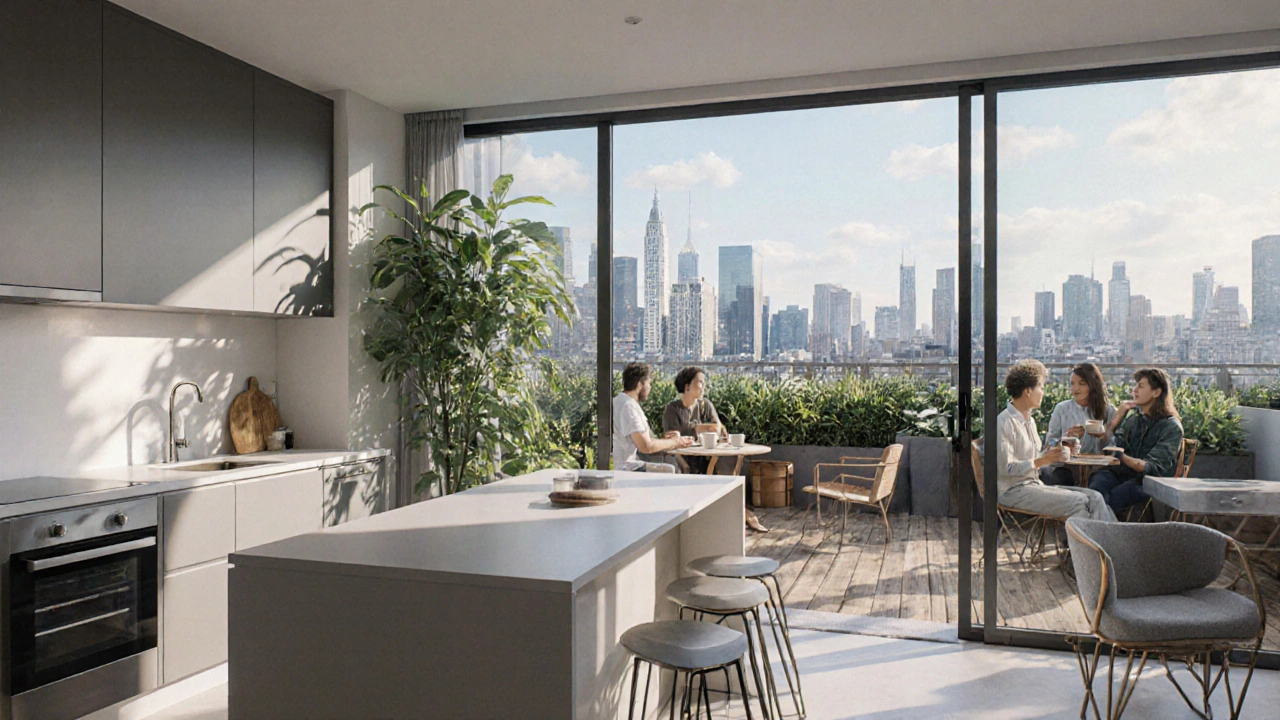Rent-to-Income Calculator for City Living
The article recommends keeping rent below 30% of your gross monthly income. This calculator helps you determine if your housing costs are within the affordable range for city living.
Enter your income and rent to see your ratio.
Ever wondered what it really feels like to call a bustling metropolis home? Big City Life the everyday experience of living in densely populated urban centers is a mix of nonstop energy, endless options, and occasional stress. This guide pulls back the city’s curtain and shares what residents actually deal with-from subway rushes to rooftop gardens. Grab a coffee, settle into a park bench (if you can find one), and let’s explore the highs, lows, and practical hacks that keep city dwellers thriving.
The Pace of the City: Why Everything Moves Fast
First thing you notice when you step onto a city street is the rhythm. Vehicles, cyclists, pedestrians, and delivery bots all jostle for space. That frantic beat is powered by Urban Transportation the network of public transit, ride‑shares, biking lanes, and walking paths that move people through a city. A well‑run subway can shave 30 minutes off a commute, but a delayed train can throw your whole day off balance.
- Metro lines often run 24/7 in cities like New York and Berlin, giving night owls a way home.
- Bike‑share programs have exploded; a dockless bike can be a lifesaver when a train is delayed.
- Real‑time apps now predict crowd levels, helping you avoid the rush hour crush.
Insider tip: If you’re new, download the city’s official transit app and set up notifications for your favorite routes. You’ll start timing your stops like a local and avoid that dreaded “train‑at‑the‑platform‑but‑never‑opens” scenario.
Finding a Home: Navigating the Housing Market the supply, demand, and pricing dynamics of apartments and houses in urban areas
Renting in a big city can feel like a game of musical chairs-when the music stops, the best spots are already taken. Prices are driven by proximity to jobs, transit hubs, and lifestyle amenities. In 2024, the average rent for a one‑bedroom in Manhattan sat at $3,400, while a comparable unit in Brooklyn’s Bushwick was roughly $2,500.
Here’s a quick way to gauge if a neighborhood fits your budget and lifestyle:
- Identify your must‑haves: walk‑score, pet‑friendly, quiet street.
- Use a rent‑to‑income calculator; aim for no more than 30 % of gross monthly income.
- Check local listings for 6‑month trends-if prices are rising fast, be ready to act quickly.
Pro tip: Consider “micro‑apartments” (around 300 sq ft) that come with shared amenities. They’re cheaper, and you get a built‑in community vibe when you use the communal lounge or rooftop.
Juggling Work and Play: The Work‑Life Balance the equilibrium between professional responsibilities and personal wellbeing in an urban setting
Big cities promise career acceleration, but they also drain your energy fast. The key is to set boundaries early. Many companies now offer “flex‑time” or “remote‑first” policies-take advantage of them to avoid the daily commute.
Ways to protect your sanity:
- Schedule “no‑meeting blocks” in your calendar, even if it’s just an hour.
- Join a coworking space with wellness rooms; a quick nap can boost productivity.
- Leverage after‑work fitness classes that double as social events.
When you feel the city’s 24/7 pulse pulling you in, remember that you control the tempo. A disciplined routine is your best defense against burnout.

Building a Social Life: The Social Scene the network of gatherings, events, and community groups that shape interpersonal connections in a city
Everyone swears they’re “busy” and making new friends can seem impossible. The trick? Upgrade from passive scrolling to active participation.
Try these low‑commitment ideas:
- Attend a “meet‑up” for a hobby you love-board games, hiking, or language exchange.
- Volunteer at a local shelter or food bank; you’ll meet purpose‑driven people.
- Join a community garden; it doubles as a green escape and a conversation starter.
Remember, in a city of millions, the most meaningful connections often come from niche groups where you share a common interest.
Making Space for Yourself: Public Spaces parks, plazas, libraries, and other communal areas that offer respite from the urban hustle & Noise Pollution unwanted or harmful sounds that affect health and comfort in dense environments
Even the best‑priced apartment can feel claustrophobic if you can’t escape the sirens and traffic roar. That’s where urban living tips shine: seek out quieter corners.
Top quiet‑oases in major cities:
- New York’s Elevated Acre-a hidden rooftop garden above a parking garage.
- London’s St. Dunstan in the East-a repurposed warehouse turned serene park.
- Tokyo’s Meguro River Walk-perfect for early‑morning runs.
Buy noise‑cancelling headphones for the commute, but also consider sound‑absorbing curtains or white‑noise machines at home. A quiet bedroom can dramatically improve sleep quality.
Eating Your Way Through the City: The Local Food Scene the array of restaurants, markets, and street‑food options that reflect a city’s cultural diversity
One of the biggest perks of big‑city living is the food variety. From rooftop sushi bars to hole‑in‑the‑wall tacos, the options are endless-but they can also be pricey.
Smart ways to savor the scene without breaking the bank:
- Follow “happy hour” feeds on social media; many places slash prices after 5 pm.
- Visit farmer’s markets for fresh produce and craft foods at lower costs than upscale restaurants.
- Try “pay‑what‑you‑can” community kitchens that rotate menus weekly.
And don’t forget the power of a good lunch‑box. Packing a simple salad and a reusable mug can save $10‑$15 per workday.

Money Matters: Cost of Living Comparison
| Expense | Big City | Suburban |
|---|---|---|
| Rent (1‑bedroom) | $3,200 | $1,800 |
| Public Transit Pass | $127 | $95 |
| Groceries | $350 | $300 |
| Utilities (electric, water, internet) | $180 | $150 |
| Entertainment & Dining Out | $250 | $180 |
These numbers show why budgeting is a must in the city. The extra $1,500 you spend on rent and entertainment can be redirected toward savings if you manage other categories wisely.
Quick Checklist to Thrive in the City
- Download and set up the city’s official transit app.
- Calculate your rent‑to‑income ratio; keep it ≤30 %.
- Reserve “no‑meeting” blocks each week.
- Join one local hobby group or volunteer program.
- Identify two quiet public spaces for weekend recharge.
- Plan weekly meals using farmer’s market finds.
Follow these steps and the city will feel less like a race and more like a playground you’ve learned the rules to.
Frequently Asked Questions
How can I find affordable housing in a high‑cost city?
Start by using rent‑tracking websites that show historic price trends. Look for neighborhoods undergoing “gentrification” where rents are still below the city average, and consider co‑living arrangements or micro‑apartments that share amenities to cut costs.
What are the safest ways to commute after dark?
Stick to well‑lit stations and use ride‑share apps that show driver ratings. Many cities now offer “night‑only” subway services with increased security patrols. Pairing a friend or using a trusted bike‑share program with GPS tracking also helps.
How do I combat noise pollution in a busy apartment?
Install acoustic curtains and add rugs to absorb sound. White‑noise machines or fan apps can mask street noise. If it’s a chronic issue, talk to your landlord about double‑glazed windows; many are willing to upgrade for a small fee.
Where can I meet like‑minded people without spending a fortune?
Check out free local meet‑ups on platforms like Meetup.com, attend community library events, or volunteer at city parks. Many cafés host free board‑game nights on weekdays, offering a low‑cost social setting.
Is it worth paying for a gym membership in the city?
If you use it at least three times a week, the cost per visit drops below $10, making it comparable to a weekly take‑out meal. Look for boutique gyms that bundle classes, or use your employer’s wellness stipend for discounted access.


Write a comment